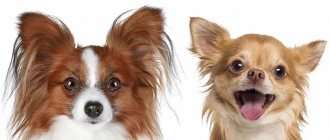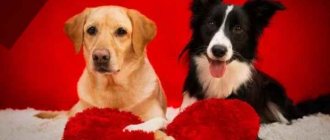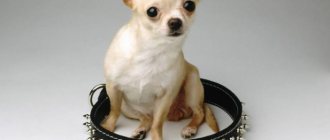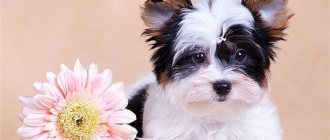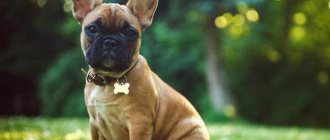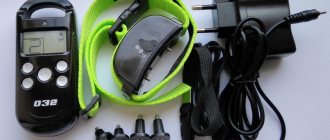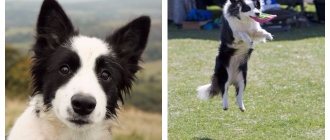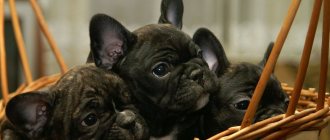What is the correct name of the breed?
The breed, which is often called the dwarf Doberman and mini Doberman, does not actually exist.
In the standard it is written as a miniature pinscher . But there is still some similarity with Dobermans, and it is explained by the fact that Karl Doberman developed his breed based on miniature pinschers.
Character
This breed of dog is unlikely to be suitable for a beginner. To properly raise a wayward puppy you will need an experienced dog breeder . He will be able to make him a faithful and devoted friend, as well as a fearless assistant and guard.
The breed is easy to train, it is active and fearless . Such character traits are positive qualities for choosing a dog as a guard. They are good protectors for their owner and are ready to sacrifice themselves for him.
If you raise a dog correctly, it will turn out to be an affectionate, loving and devoted dog. This is a proud and very brave dog, ready to protect its owner at any time. They treat children well, however, they do not tolerate disrespectful behavior towards themselves. They do not need to be placed with babies who might hit or pinch the Mini Doberman . In this case, the dog will respond to the insult.
If raised properly from the start, the Miniature Pinscher will make an excellent companion. It is ideal in the following cases:
- if the owner loves walks in the fresh air;
- there are children over 5 years old in the family;
- the owners are full of strength and energetic;
- there are no other pets in the house.
They can treat other pets in the house with love and respect, but only if they grew up together. In city conditions, it is advisable to take him out only on a leash. They need constant attention because they react jealously to a lack of attention to themselves. Since the breed is very active, experienced dog handlers recommend purchasing toys for it, as well as teaching it something new. You need to start training your dog from childhood, teach him various tricks, commands, and take him for walks more often.
Origin story and what it looks like in the photo
The first mentions of miniature pinschers date back to the 15th century . In Germany, in a city called Württemberg, like all cities of the Middle Ages, there was an acute problem with a large number of rats.
At that time, they were actively engaged in breeding a breed that could fight them.
It was on this basis that these dwarf dogs appeared. Also, the miniature pinscher was indispensable for hunting, this allowed him to become an almost universal dog.
The breed gained second popularity in the 20th century, but it has already begun to be adopted as a companion..
Pet character
This is a very capricious breed that requires constant watch and control . This is a very jealous dog. He won't tolerate it if you stop giving him influence.
For the same reason, mini Dobermans are distrustful of strangers, especially if the owner is favorable to them.
Despite the fact that the dog is small, he will without hesitation defend his owner and the rest of the family. At the same time, the dog does not warn about its intentions and will always attack first.
For the same reason, you need to walk your dog on a leash to avoid any unpredictable moments..
Dog socialization should be done as early as possible. A dog that communicates with other relatives grows up calm, balanced and with high intelligence.
Expert opinion
Kozhevin Semyon Kirillovich
Expert dog handler.
“The dog is very self-confident and domineering, if its character is not suppressed, it will sit on the neck and very quickly. She needs someone with the same temperament next to her. She doesn’t like children, so you should always pay close attention to how your pet and your child play. Always attacks without warning and with aggression. But in general, if raised correctly, the dog will never offend without reason. He is always in the best mood towards his owner.”
Miniature Pinscher personality traits
Cheerful, irrepressible dog. Constantly on the move. It has an obstinate disposition; if the owner does not dominate, it becomes difficult to control. Loves to run. Noisy dog, requires training. They get along well with other animals only if the pinscher has grown up with them. If you try to get someone else with an adult dog, you will run into a sharp protest. The pet will perceive the newcomer as a rival. Pinscher is a big jealous person.
Positive qualities: a wonderful guard, barks loudly at strangers. Gets along well with older children; you can raise a minipin to be a personal security guard for a child. Enjoys playing outdoor games with children.
Attention: children should not play with a mini Doberman; a careless action may result in him snapping and even biting, or the child may accidentally injure the animal.
Rich in inventions and tricks. Considers himself a protector of family and home. It can attack a stranger if it senses danger, assesses its capabilities well, and will not rush into battle recklessly. If the enemy takes more and stronger by cunning.
Negative qualities: loves to dig and dig, spoils furniture; to avoid this, exhaust your pet well with games during a walk. A loud voice and frequent barking can disturb neighbors.
Breed standard
| Part of the body | Description |
| General form | It is a smaller copy of the German Doberman Pinscher. He does not have all the disadvantages that mini breeds have. This is a graceful, smooth-haired dog whose body resembles a square. |
| Head | The skull is oblong, without an occipital protuberance. The forehead is flat, the transition from it to the muzzle is insignificant. Black nose, black lips adjacent to the jaw. Strong jaws and scissor bite. The eyes are dark and oval. Ears erect or hanging on cartilage. Triangular. |
| Neck | Graceful, smoothly curved, medium length. The base is not marked; it transitions smoothly to the withers. It has no dewlap and dewlap. |
| Frame | The topline is slightly sloping, with the withers forming the highest point of the topline. The back is strong and elastic. The croup is rounded, merging into the base of the tail. The chest is moderately wide, the sternum protrudes. The sides are not quite matched. The tail is not docked. It has a saber or crescent shape. |
| Limbs | The forelimbs are strong and not placed close together. The humerus bones fit tightly to the body. The forearms are straight, strongly developed. The front paws are elastic and strong, the toes are arched, the pads are elastic and black. The hind limbs are slightly set back. The thighs are moderately wide and very muscular. Hock joints with pronounced angles, metatarsus set vertically. The hind legs are slightly longer than the front legs. Fingers are closed, arched. Claws and pads are black. |
| Movements | The breed is a trotter. The back remains strong while moving. The dog moves effortlessly, smoothly and harmoniously with a typical free sweeping trot. |
| Leather | Must fit snugly around the entire body |
| Coat | The coat should be free of bald spots. Short, thick, shiny, also tightly fitting. |
Breed standard and description
There is no separate standard for males and females, as the differences are minor.
Height at withers: 25 to 30 cm
Weight: from 4 to 6 kg
Color:
- Black and deep red,
- Black and light red,
- Chocolate and rich red,
- Chocolate and light red,
- Ginger,
- Red deer.
additional characteristics
- Experts believe that the best proportion in the physique of miniature pinschers is when the length and height of the body are approximately the same.
- The size of the muzzle should be half the length of the body from the nape to the base of the tail.
- The miniature should not have too long legs, and the skull should not be round.
- The eyes are only dark, oval in shape, it is desirable that the eyelids are painted black.
- The ears are erect or curled at the ends.
- The nose is black.
- In addition, the dog should not walk excessively as this is a disqualifying sign.
Cupping
There used to be a strict requirement by all associations for tail docking , partly because working dogs were often attacked for their long tails due to their mobility.
Now in many countries this action is considered unnecessarily cruel and dogs with long tails are allowed into exhibitions. If you prefer to dock your tail, then the optimal age for this is 3-5 days . At this time, the puppy's nervous system has not developed enough to feel pain.
Advantages and disadvantages
Advantages:
- A small dog that can be kept even in small apartments and rooms, unlike the larger Doberman;
- Very good health, with minimal risk of hereditary defects;
- Very hardy and active, likes long walks;
- Hears well and has an excellent sense of smell;
- It has no undercoat, which means that a person with allergies can get such a dog;
- Short hair hardly sheds;
- There is no specific dog smell;
- They are not friendly in food, but it must be special due to their active lifestyle;
- Will become an excellent guard on its territory;
- They listen to the owner and learn quickly;
- Loyal and faithful to their person;
- They are calm with other pets and children;
- The breed can be litter trained.
Flaws:
- Hyperactivity may develop;
- Desperate bullies who will attack without hesitation;
- They bark loudly and shrilly;
- Very wary of strangers, no matter what relationship the owner has with them;
- They cannot stand loneliness. They take revenge for him by damaging things and furniture;
- They love long and active walks all year round. At least one trip outside per day is necessary;
- His favorite pastime is digging, because in the past dogs were rat catchers;
- During the cold season, you will need clothing;
- They are very cunning, you cannot show weakness around them;
- They love to manipulate the rest of the household.
Maintenance and care
This breed is exclusively for indoor use, not outdoors. An animal should have its own place in the house. You need to understand that a representative of this breed will jealously guard it, so it is better to clean it in his absence.
Needs long walks outside, during which the owner will play outdoor games with him. It's better not to let him off the leash. When leaving him at home alone, you need to offer him a whole arsenal of toys.
Rules of care:
- Mini Dobermans are very rarely dirty. Therefore, after a walk, it is enough to dry your pet’s fur with a towel;
- Pinschers are washed several times a year. More frequent washing leads to colds and flaking of the skin;
- Shedding is insignificant; no brushing is required;
- Ears and claws need attention.
Never carry your Pinscher by the scruff of the neck. The dog will have a painful tendon injury.
In order to protect your pet from diseases, he needs to purchase clothes for the cold season. It should not be tight and made of warm and water-repellent material.
Size, weight and other distinctive features
For females and males, height is 25-30 cm and weight 4-6 kg.
Weight is the main characteristic of the mini Doberman. Due to its excessive activity, the dog can be too thin, and if the diet is chosen incorrectly, it can become obese.
NOTE!
The following are also uncharacteristic of dogs: cowardice, unreasonable aggression, obvious distrust or nervousness.
Also pay attention to height - it should not exceed standard values by more than 2 cm.
Breed
Even at such a low weight and height, the miniature pinscher is able to prove to everyone that he is a personality to be reckoned with. Dogs of this breed are not at all bothered by the fact that their height barely exceeds 30 cm, and their body weight rarely reaches 6 kg. Even with such parameters, they continually try to put themselves above those around them. The desire to dominate manifests itself both in communication with people and with dogs.
Important! Mini Dobermans love to attract attention to themselves and it doesn’t matter how they do it, the main thing is to achieve the desired result.
Miniature pinschers show love for their owner everywhere and always. These dogs are very emotional and know how to use this to their advantage. Miniature pinschers love to manipulate, thereby achieving affection, an extra piece of treat or an unscheduled outing for a walk. Owners who do not know about such character traits of their pets and are “led” by their plaintive appearance will soon regret it very much - it is very difficult to bring down an arrogant miniature pinscher from heaven to earth.
Important! So that during walks the mini Doberman, who is trying to prove to everyone that he is the most important, does not have problems with taller and larger dogs, he needs to be taken out on a leash.
A miniature pinscher can make a good guard. Of course, in most cases he will not be able to emerge victorious from an unequal battle with an attacker, but the pinscher will be able to notify the owner of uninvited guests. These miniature dogs, despite their eccentricity and restlessness, have a very strong and stable nervous system. They rarely show aggression and do not bark over trifles.
Important! A miniature pinscher will be able to get along with another dog, but will never make friends with a cat unless they grew up under the same roof.
Miniature pinschers belong to the category of dogs that are difficult to keep in one place. They will not lie down on the sofa, even in old age. Overwhelmed by a thirst for activity, they never stop at an unfinished task. If you want to properly examine or sniff something, dwarf pinschers will crawl into the narrowest crack and climb onto the highest shelf in the apartment.
The smart, intelligent Miniature Pinscher is very easy to train. However, you shouldn’t relax too much because of this - even the slightest indulgence in the training process and the dog will immediately “sit on the neck” of its owner. Feeling that the person has given up, the pinscher will immediately take control of the process into his own paws.
Important! It is impossible to forgive and put the brakes on disobedience to a miniature pinscher. Punishment, of course, not physical, must be timely.
You can and should engage in dog sports with a mini Doberman. Dogs that can jump over an obstacle that is many times higher than their own height are simply created for agility.
Popular colors
The breed standard only recognizes 2 colors for the Miniature Pinscher:
- Black and Tan . Markings should be on the inside of the ears, eyebrows, muzzle, chest, throat, pasterns, paws, on the inside of the hind legs, under the base of the tail.
- Ginger . This is a solid color that covers the dog's entire body.
Previously, there was also a brown and tan color, but today such dogs are bred only in the USA.
What diseases are they susceptible to?
Despite their excellent character, there are diseases that can still occur in miniature pinschers:
- Eye diseases (cataracts, glaucoma, entropion, corneal dystrophy);
- Diabetes mellitus and urolithiasis;
- Joint problems (shoulder dislocation, Perthes disease);
- Obesity;
- Pancreatitis.
Do not try to treat your dog yourself, especially with human medicine.
Care and maintenance
Caring for a dog is not difficult at all, it will only take a lot of time at first, and then you will get into the rhythm:
- You should walk your dogs at least once a day. The average duration of the walk should be 30 minutes;
- Prefer a harness over a leash. This will make walks more comfortable for the dog;
- Brush your pet 2 times a week. Be careful which comb you choose: it should not injure the animal;
- Mini Dobermans need to be bathed when they get dirty. On average this is 1 time per month;
- Wipe your pet's eyes 1-2 times a week. This can be done with a special lotion or chamomile decoction;
- You need to clean your ears once a week;
- Inspect your pet's teeth, make sure that tartar does not appear. To avoid this disease, brush them 1-2 times a week with a brush and a special paste or give them special treats;
- Trim your claws as they grow;
- After each walk, inspect the paw pads. Make sure there are no wounds, cracks or calluses;
- Vaccinate, worm, and treat fur against fleas and ticks in a timely manner.
Hygiene
The short hair of the Mini Doberman is combed with a soft brush at least twice a month. Bathing is recommended twice a year. You shouldn’t do this more often—washing your paws every day after walks and wiping the dog’s fur with a damp sponge is enough.
The dog's nails are trimmed once every two weeks. The ears of miniatures are massaged to maintain the correct shape. To do this, grasp the shell with two fingers and lightly massage the cartilage towards the tip, while simultaneously pulling the ears up.
What is the difference between mini Dobermans and Dobermans
Dobermans and mini Dobermans are very different from each other. Their similarity lies only in appearance - similar color, and miniature pinschers sometimes have their ears cropped.
Otherwise, they are very different: miniature pinschers do not have their tail docked , they are more aggressive, their hunting instinct is better developed, and they are more often disobedient .
And in general, these two breeds have different areas of activity: Dobermans are good at military service and its varieties, and mini-Dobermans are companion dogs and hunter’s assistants.
Proper feeding
Proper nutrition is very important for this breed. The choice of food depends on the owner, but it must be balanced and healthy.
IMPORTANT!
Up to 4 months, puppies need to be fed 6 times a day, and after this age, gradually reduce the number of feedings so that by the age of one year they are 2 times a day.
Miniature pinschers have very weak digestion, so make a choice - dry or natural food, but do not combine.
The menu should include the following products:
- Meat should always predominate; chicken or turkey is suitable for poultry;
- Fruits should also be given: pear, apple, banana, dried apricots as a treat;
- Boiled egg once a week;
- You can give fish, but only sea fish and no more than once a week;
- By-products can diversify your pet's menu: liver, heart, lung, tongue;
- Give fermented milk products - cottage cheese and low-fat kefir;
- Buckwheat and rice are suitable cereals;
- Miniature pinschers benefit from goat's milk;
- Vegetables should not be excluded either - carrots, cauliflower, broccoli, pumpkin;
- Always make sure the water in the bowl is fresh.
Prohibited foods include: white cabbage, river fish, bones, semolina, baked goods, sweets, smoked foods, sausages, citrus fruits, fatty meat, cow's milk, as well as all food from the human table.
How to choose a puppy
First of all, you need to focus on the standard, although this is still difficult to do with puppies.
Ask to look at the parents and their documents, so you can be sure that the puppies really belong to this breed. Choose active, friendly, but not aggressive or cowardly ones.
The dog should not have external defects - lameness, malocclusion, different lengths of limbs . He should look and act like a healthy puppy.
The mucous membranes should be clean, there should be no unpleasant odor from the mouth and ears.
The coat should be free of bald spots, fleas and ticks. The puppy's appetite should be healthy, and the presence of any parasites in the feces is not allowed.

